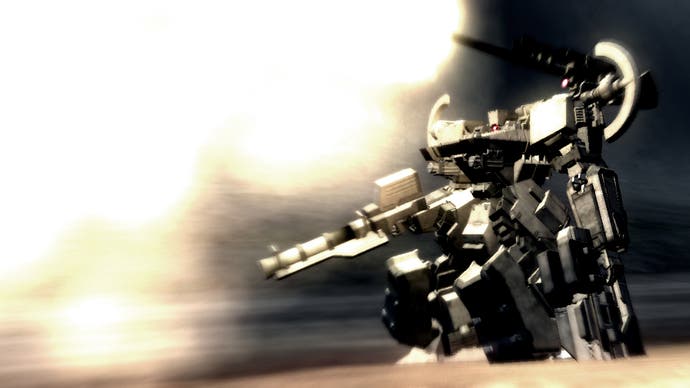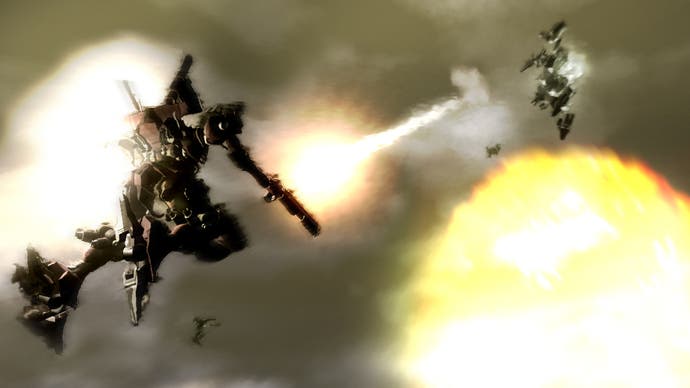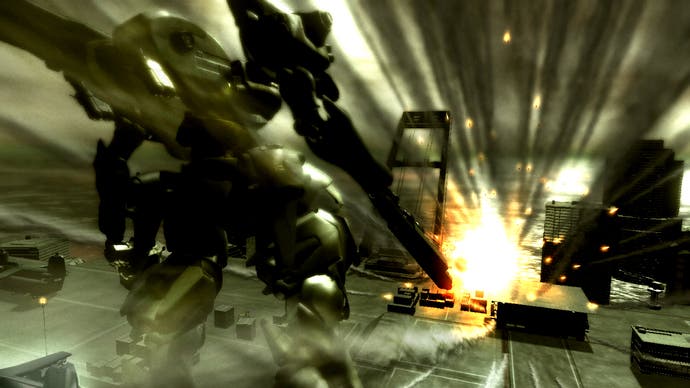Armored Core 4
Mechs appeal.
It might be the first to appear on the PlayStation 3, but Armored Core 4 is actually the twelfth game in the series. The chances are, though, that you won't be too familiar with any of the previous 11 games in the Armored Core series, so here's a quick rundown: create or customise a big robot (called, appropriately enough, an Armored Core, or AC) by choosing from hundreds of body and weapon parts. Then fight other big robots, either in one-on-one arena battles or in more elaborate missions. It's a simple formula, which conceals an enormous amount of depth. But it's not a formula that, so far, has had a huge amount of commercial success outside Japan and the US.
Partly that's because of the idiosyncrasy of the game's default control scheme, which forced players to move around using the d-pad and look up and down by using the triggers, instead of simply using the two analogue sticks like every other third-person title in existence. But actually, the clunky controls did a good job of capturing the lumbering sense of scale of piloting a big stompy robot.

So the most obvious thing about Armored Core 4 (apart from the fact that it's on the PlayStation 3) is that they've changed the control scheme. Now, as with every other third-person title in existence, one analogue stick is used to move and the other to look around. Not that the sense of piloting a complicated piece of machinery has entirely vanished: you'll still need twenty fingers to switch between your various weapons while strafing, boosting, dodging and launching countermeasures. Still, the result, along with a cleaner, clearer HUD design and a couple of tweaks to the gameplay (no more overheating, greater freedom to use your AC's booster), is a more accessible, more streamlined, and a much faster, more fluid game than previous Armored Core titles.
Of course the other big departure from previous games is that it's now on the PlayStation 3 (did we mention that already?). Consequently there are one or two sweet technical flourishes, from the grainy realism of the cut-scenes that bookend the game's chapters to some of the lighting effects, and even just the neat fade-out at the end of missions. Nothing revolutionary, for sure, but pretty agreeable all the same - as are the environments in which missions take place, which are almost universally awesomely pretty. Over the course of the game you'll duel enemy ACs against moody sunsets, smash through ice floes, dodge helicopter gunships while surfing through sunken cities, struggle through oppressively intense sandstorms, and even operate in the pitch dark - your way lit up only by the occasional explosion and traces of gunfire.

Those are the big differences, but in substance Armored Core 4 will be familiar to anyone who's played any of its predecessors - which means there is an almost forbidding degree of choice. At any point in the game you can edit the colour scheme of your AC in intricate detail, right down to designing new decals and emblems. Then there's the more complicated issue of choosing your AC's body parts and weaponry in order to make the most badass big robot possible. Choose between four legs, two legs, tank legs, weapon arms, standard arms, grenade launchers, rocket launchers, pulse guns, machine guns, radar...
Everything in the game is a trade-off between manoeuvrability/speed and firepower/armour, and although the scale is slightly overwhelming, you can choose from one of six pre-configured ACs at the start of the game. The upside to this level of customisation is, of course, that it provides enormous potential to tailor the game to your chosen style of play, be that of a ponderous walking tank, or a stripped-down and speedy melee assassin. Either way, once you've tailored your AC, it's off to the next mission briefing and then on to a mission - most of which are actually pretty brief.

Brief, but absorbing; occasionally epic, and frequently full of memorable set-pieces. Most of the missions ultimately boil down to destroying the bejesus out of pretty much everything, but there's a remarkable degree of ingenuity in the way you go about it, and most of the time you'll need to filter out the battlefield noise to focus relentlessly on reaching your primary objectives. Again, in this respect, the game is typical of the series so far, and features a good variety of objectives and enemy types: shoot down swarms of enemies, escort transport vehicles, destroy key objectives. Take, for example, a mission in which you parachute down into a chimney, aligning yourself for the drop while avoiding serious incoming fire. Or a mission in which you have to defend a tanker from occasionally surfacing submarines (hint: a good radar comes in handy here). There's certainly enough variety to reward the multitude of playing styles made possible by the emphasis on customisation.
And there's more, in the shape of arena battles (now called 'Simulation' battles) against individual enemy ACs (who are much more taxing opponents than the cannon-fodder found in most of the missions). It's a good proving ground in which to learn the subtle intricacies and tactics required for the multiplayer modes, which are essentially an extension of the Simulation mode, offering robust one-on-one, team-play and free-for all arena battles for up to eight players.

If the game does have a flaw it's the severity with which the difficulty level occasionally spikes. Although the game appears to offer total open-ended freedom to adopt whatever battle tactics you might care to use, there are certain missions that require a pretty specific approach, resulting in successive unsuccessful attempts before you alight upon the correct configuration. Other minor niggles include annoying load times between menu screens, the brevity of the single-player campaign (it's just 37 missions long and, difficulty spikes aside, fairly easy to breeze through) and, ultimately, a slightly weary sense of familiarity for anyone who's played through those previous 11 games.
But for anyone who hasn't had that pleasure, this is probably the best place to start. Armored Core 4 is more accessible than its predecessors; and at its core, beneath the complicated controls and imposing arsenal of body parts, it's a pretty simple, superfast, graceful and smart mech-combat game, and it deserves your attention.







